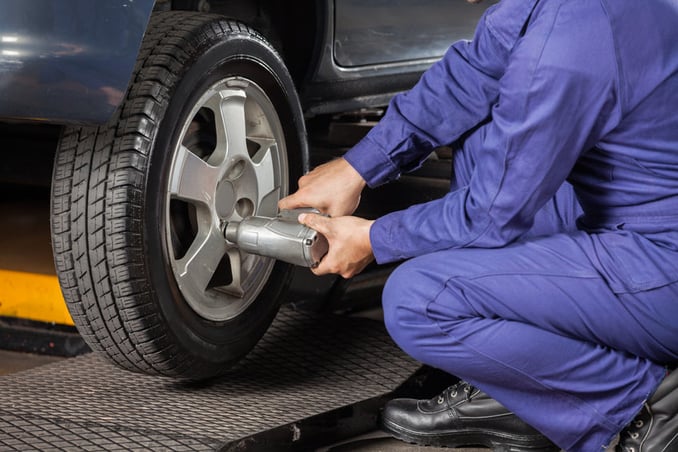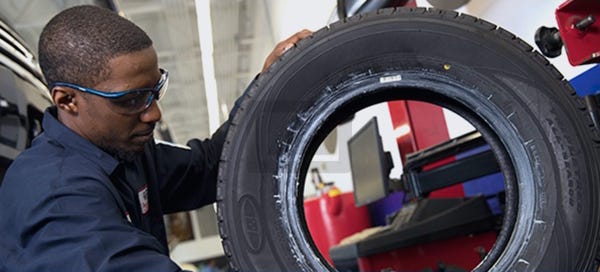Obtain Road-Ready with Expert GMC Tires Service at Morris Tires
Obtain Road-Ready with Expert GMC Tires Service at Morris Tires
Blog Article
Tire Solution: The Influence of Weather
When it comes to making certain optimal efficiency and safety and security when traveling, recognizing the impact of weather on tire solution is critical. From scorching warmth to icy roadways, each weather condition aspect can dramatically influence tire capability and overall driving experience. By diving right into the impacts of varying climate condition on tires, vehicle drivers can get valuable understandings that might improve their car's performance and longevity. In this discussion, we will check out the complex relationship between climate condition and tire solution, shedding light on the value of weather-specific tire maintenance techniques and factors to consider.
Heat and Tire Performance
When exposed to high temperature levels, tires experience changes in performance that can considerably affect automobile safety and security and handling. The warmth generated from extended driving or heat conditions causes the tire rubber to soften, causing reduced walk life and increased wear. As the rubber becomes softer, the tire's hold when traveling lessens, influencing stopping distances and overall traction. In extreme cases, excessive warmth can also create tire blowouts, posing a serious safety and security threat to the lorry and its owners.

Cold Weather Results
Winter conditions can have a substantial effect on tire performance and safety. As temperatures drop, tire rubber can solidify, leading to reduced traction on icy or snow-covered roads. In chilly weather condition, tires might likewise lose atmospheric pressure a lot more swiftly, which can impact taking care of and gas performance. Furthermore, cold temperature levels can create tire sidewalls to stiffen, raising the danger of damage from splits or various other road dangers.
To reduce the results of chilly climate on tires, it is important to frequently examine tire pressure and inflate them to the manufacturer's recommended levels. Using wintertime or all-season tires designed for winter conditions can additionally improve grip and grasp on icy or snowy roads. Correct tire maintenance, consisting of normal assessments for wear and damages, comes to be much more crucial throughout cooler months to guarantee optimal performance and safety.
Rainy Issues Impact
Tires with worn-out footsteps are more vulnerable to hydroplaning, where a layer of water develops up between the roadway and the tire surface area, leading to loss of grip. To battle this, chauffeurs must regularly evaluate their tires for ample walk depth and consider investing in tires specifically designed for damp problems.
Additionally, rainy weather can also lower presence, making it challenging for chauffeurs to see the roadway ahead plainly (GMC Tire Service). In such problems, it is important to readjust driving rates appropriately and keep a safe adhering to distance to enable abrupt stops. Effectively filled with air tires can additionally aid in preserving control on damp roadways by providing much better handling and grip
Snow and Tire Safety And Security
When driving in snowy conditions, having the best tires can make a considerable distinction in security and efficiency. Wintertime tires are designed with special rubber compounds and step patterns to provide better traction on snow and ice contrasted to all-season tires.

It is vital to adhere to producer directions when utilizing and setting up tire chains to prevent damage to the tires and lorry. By selecting the ideal tires, preserving appropriate rising cost of living, and thinking about extra traction help like tire chains, motorists can enhance their safety and security when browsing snow-covered roads.
Weather-Related Tire Maintenance
When encountered with various weather, proper tire upkeep becomes an essential element of car safety and security and performance. Weather-related tire upkeep encompasses a variety of techniques targeted at guaranteeing optimum tire function and durability in various weather situations. One vital element of weather-related tire upkeep is tire pressure guideline. Fluctuating temperature levels can create tire pressure to vary, affecting grip and gas performance. Consistently readjusting and inspecting tire stress according to maker recommendations is vital for secure driving in changing discover here climate condition. Additionally, tire tread depth plays a considerable function in managing various weather condition components. Tires with ample step depth offer far better hold on wet or icy roadways, reducing the danger of hydroplaning or skidding. When step wear reaches a certain depth is important for maintaining traction and security in damaging weather condition, evaluating tire tread on a regular basis and replacing tires. By prioritizing weather-related tire maintenance, motorists can boost safety, improve lorry performance, and extend the life-span of their tires.
Final Thought
In verdict, climate conditions have a significant influence on tire efficiency and safety and security. From heat affecting tire pressure and put on to winter lowering grip, it is important to consider the climate when preserving and utilizing tires. Wet problems can decrease hold and cause hydroplaning, while snow can enhance the threat of crashes if tires are not correctly geared up. Weather-related tire maintenance is critical in making certain ideal efficiency and safety when driving.
In this discussion, we will certainly discover the intricate partnership in between climate conditions and tire solution, shedding light on the relevance web of weather-specific tire maintenance practices and factors to consider.

Report this page